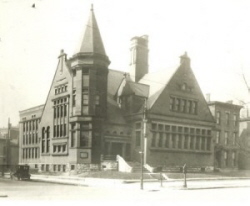Calm: 1889-1895
In 1889, shortly after Boyce’s death, Dr. Broadus accepted the call to the presidency. The seminary set a steady pace under Broadus as attendance rose and Southern inaugurated a postgraduate studies program. In the early 1890s, the school began offering both a Master of Divinity and a Doctor of Philosophy, in place of the “Full Graduate” degree of the past.
Under Broadus, the seminary drew a talented group of professors that constituted the second generation of Southern faculty. The group included A. T. Robertson, professor of New Testament and Greek; E. C Dargan, professor of Homiletics and Latin Theology; W. J. McGlothlin, assistant professor of Old Testament Interpretation; H. H. Harris, professor of Biblical Introduction and Polemic Theology, and W. O. Carver, professor of comparative religion and missions. John Sampey, professor of Old Testament Interpretation, had joined the faculty just before the passing of Boyce, as had F. H. Kerfoot, professor in systematic theology. These scholars shaped the denomination as they taught and worked alongside several generations of SBC leaders on various boards and agencies.
These professors began their careers in a season of change for the Christian church. Many evangelicals embraced liberal theology that recast Christian doctrines. This body of thought emphasized man’s autonomy, reason’s potency, and truth’s subjectivity. In the years that followed, numerous professors adopted aspects of its system.
In 1890, the seminary named James L. Sampey, father of professor John R. Sampey, the seminary’s first salaried librarian. Sampey administered a collection of fifteen thousand volumes, a large portion of which came from the estate of James P. Boyce, who gave five thousand books and pamphlets to the Seminary upon his death. Fellow founder Basil Manly, Jr. also gave a personal library of thirty-five hundred books to the seminary. Dr. Sampey tended the collection in the seminary’s first library, Memorial Library, following its construction in 1891.
The steadiness of the first half of the 1890s gave way to sadness when the final member of the founding faculty, John A. Broadus, breathed his last. Professor Sampey remembered the event in his Memoirs: “When we turned away and left the cemetery, many of us were wondering how we could carry on without Dr. Broadus. To whom could we go now for counsel about our problems? Who now could speak the word that would rally Southern Baptists to their task? Our hearts were sad and discouraged.” (1) It was the end of an era.
(1) John Sampey, Memoirs, 71.


